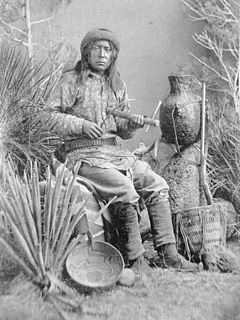Apache fiddle

Chasi, a Warm Springs Apache musician playing the Apache fiddle, 1886, photo by A. Frank Randall[1]
The Apache fiddle (Apache: tsii" edo'a'tl, "wood that sings")[2] is a bowed string instrument used by the indigenous Apache people of the southwestern United States. The instrument consists of a plant stalk, such as that of the agave or mescal plant. One or sometimes two strings, often made of horse hair, are secured at both ends of the stalk, a bridge and nut added, and the string is played with a bow. The string is touched with the fingers to change its note.
The Apache fiddle is believed to be based upon fiddles brought to North America by European settlers. The Smithsonian Institution holds an Apache fiddle collected in 1875.[3] In 1989 Apache fiddle maker Chesley Goseyun Wilson of Tucson, Arizona won a National Heritage Award.[4]
See also
References
- ↑ "Portrait of Chasi, Bonito's Son..." National Anthropological Archives. (retrieved 11 June 2010)
- ↑ Experimental Musical Instruments. Experimental Musical Instruments. 1995. p. 34.
- ↑ American Indian art magazine Published by American Indian Art, Inc., 1980. Original from the University of Michigan. Digitized Dec 19, 2007. Page 28.
- ↑ 1989 NEA National Heritage Fellow: Chesley Goseyun Wilson, National Endowment for the Arts (USA)
Sources
- Native American Stringed Musical Instruments by Daniel Brinton. in The American antiquarian and oriental journal By Stephen Denison Peet Jameson & Morse, 1897 v. 19, pg 20.
- The Apache Violin: Indigenous violin music in South and North America Jon Rose Web, 2005
| ||||||||||||||||
